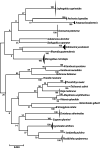Discovering the fish fauna of a lagoon from the southeast of the Yucatan Peninsula, Mexico, using DNA barcodes
- PMID: 37933260
- PMCID: PMC10625761
- DOI: 10.7717/peerj.16285
Discovering the fish fauna of a lagoon from the southeast of the Yucatan Peninsula, Mexico, using DNA barcodes
Abstract
Background: Aquatic ecosystems in the tropics are typically environments with a high species richness of fishes. These systems are also among the most vulnerable in the world, threatening the overall biodiversity of tropical regions. As a first step, it is important to enumerate the species in any ecosystem to promote its conservation. This study aims to inventory the ichthyofauna in the Chile Verde Lagoon, Quintana Roo, on the Yucatan Peninsula, a system fortunately well protected in Mexico, based on faunal surveys backed up with mtDNA barcodes.
Methods: We collected larvae, juveniles, and adults of fishes in the lagoon with a variety of sampling gear targeting various life stages. Species were identified using both morphology and DNA barcodes. The abundance of species and ichthyoplankton biomass (wet weight, suction technique) were calculated from 43 samples.
Results: We collected 197 adult and juvenile fishes and 3,722 larvae, of which 306 specimens were DNA-sequenced with a success rate of 96.7%. We identified 13 families, 24 genera, and 27 species in our inventory. The species number was estimated to comprise 75% of the potential total richness using the Chao 1 richness estimator. Clupeids and gobiids accounted for 87.9% of the total abundance of fishes, and, together with cyprinodontids, also accounted for the highest ichthyoplankton biomass.
Conclusion: Adult and juvenile fishes were identified by morphology and meristic values, however larvae required DNA barcoding to identify species. The high biomass and abundance of larvae of clupeids, gobiids and cyprinodontids suggests that the Chile Verde Lagoon may be important for reproduction of these species in the region. Microgobius microlepis, a marine goby species, is reported for the first time in an inland oligohaline system. This study provides a basis for future environmental assessment and biomonitoring of the Chile Verde Lagoon in the Yucatan Peninsula of Mexico.
Keywords: Biodiversity; Diversity; Epicontinental fishes; Fish larvae; Freshwater; Quintana Roo.
©2023 Uh-Navarrete et al.
Conflict of interest statement
The authors declare there are no competing interests.
Figures






Similar articles
-
Hydroids (Cnidaria, Hydrozoa) from Mauritanian Coral Mounds.Zootaxa. 2020 Nov 16;4878(3):zootaxa.4878.3.2. doi: 10.11646/zootaxa.4878.3.2. Zootaxa. 2020. PMID: 33311142
-
Fish diversity and assemblage in the Batticaloa lagoon, Sri Lanka.J Fish Biol. 2023 Apr;102(4):773-793. doi: 10.1111/jfb.15314. Epub 2023 Feb 1. J Fish Biol. 2023. PMID: 36632651
-
Spatial and temporal variation of fish assemblages in a coastal lagoon of the Biosphere Reserve La Encrucijada, Chiapas, Mexico.Rev Biol Trop. 2008 Jun;56(2):557-74. doi: 10.15517/rbt.v56i2.5608. Rev Biol Trop. 2008. PMID: 19256428
-
The mosquitoes (Diptera: Culicidae) of the Mexican Yucatan Peninsula: a comprehensive review on the use of taxonomic names.J Med Entomol. 2024 Mar 13;61(2):274-308. doi: 10.1093/jme/tjad168. J Med Entomol. 2024. PMID: 38159084 Review.
-
Identifying fish eggs and larvae: from classic methodologies to DNA metabarcoding.Mol Biol Rep. 2023 Feb;50(2):1713-1726. doi: 10.1007/s11033-022-08091-9. Epub 2022 Nov 23. Mol Biol Rep. 2023. PMID: 36418775 Review.
References
-
- Alcocer J, Escobar E. Athalassohalinity (On the concept of salinity in inland waters) Hidrobiológica. 1994;3:81–88.
-
- Bauer-Gottwein P, Gondwe BR, Charvet G, Marín LE, Rebolledo-Vieyra M, Merediz-Alonso G. Review: The Yucatán Peninsula karst aquifer, Mexico. Hydrogeology Journal. 2011;19:507–524. doi: 10.1007/s10040-010-0699-5. - DOI
-
- Beeching SC, Pike RE. Ontogenetic color change in the Firemouth Cichlid, Thorichthys meeki. Copeia. 2010;2010:189–195. doi: 10.1643/CG-09-132. - DOI
-
- Birdsong RS. A review of the gobiid fish genus microgobius poey. Bulletin of Marine Science. 1981;31:267–306.
-
- BOLD Systems Handbook: barcode index numbers (BINs) 2023. https://v3.boldsystems.org/index.php/resources/handbook?chapter=2_databa.... [20 April 2023]. https://v3.boldsystems.org/index.php/resources/handbook?chapter=2_databa...
MeSH terms
Substances
LinkOut - more resources
Full Text Sources
Research Materials

